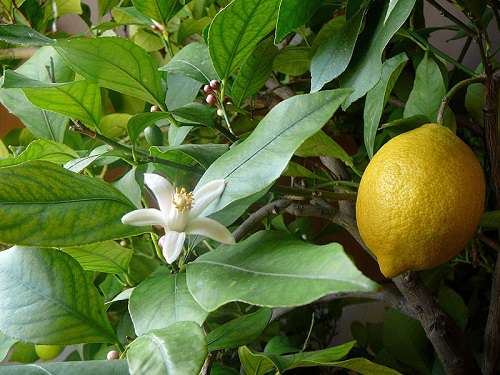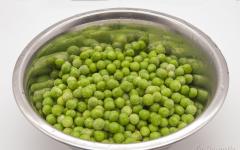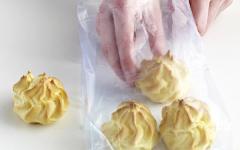Lemon is very fragrant and useful fruit. Grown in home conditions, lemons can not be compared with those purchased either for flavoring or for fragrant properties. Its application is unlimited: baking, teas, salads, jams and much more. Lemon is also widely used in folk medicine, because as in it a large number of vitamins. And the tree itself purifies the air. Very pleased with the eye when the snow outside the window, and on the windowsill among the green foliage the yellow lemon ripens.
Growing at home limonchik - it's a lot of work, and it does not always work out the first time. I will share my experience of growing this wonderful tree.
Growing lemon from a cut
Lemon can be grown from a bone, it will be more life-sustaining than grown from a cuttings, but is able to give fruit only in 15-20 years. If there is a desire to see earlier the fruits on this tree, then it is necessary to inoculate from the fruit-bearing plant. But I'll tell you how to grow a beautiful tree from a tree, from a fruit tree.
First, we need a stem from a fruit tree. Its length should be 8-12 cm, and he himself is slightly lignified, it is desirable to cut off the branch from the tree in March. And it is very important that there are 3-4 leaves on the branch.
You will also need a primer, you can use a universal one for citrus, you can cook yourself. The composition of the soil is washed with river sand and humus in equal parts. There is still a belief, from experienced florist-magnolia growers, that the lemon tree grows well in the land recruited in the place where the nettle grows well.
We also need a root stimulant Kornevin, a capacity for growing lemon (I use plastic cups, without forgetting to make a drainage hole at the bottom of the glass), a plastic bottle to create a greenhouse.


Kirovanin needed to drench the fork for a day in a solution. The solution is prepared - 1 g of the drug per 1 liter of water.
The next day, cut the leaves to half, so that the plant does not spend energy on the food leaves, and let all its life force on the root formation.

Sprinkle the bottom cut with Kornevin.
![]()
After that, insert the shank into the wet ground. Once the cutting is planted, it should be poured with standing water at room temperature. Then the shank must be closed transparent plastic bottle, cut off by the upper half. Then our little fellow needs to be put on the most sunny place, but it should be remembered that direct sunlight is dangerous for the cuttings. The stalk must be watered regularly, but do not fill and do not allow the earthman to dry out.


Approximately weeks after 3-4 should begin to appear first roots, you can open the greenhouse and gently try, how to pull the stem from the ground: if we encounter an obstacle, then we are on the right track, the roots have gone into growth. Now we need to adapt our lemon to the room conditions. Within two weeks, starting from 5-10 minutes. and gradually increasing the daily time, we open the lid on the bottle, accustoming the lemon to the room conditions. After two weeks, the shelter is cleaned.

After the stem leaves new young leaves, it is kept as an adult plant. When in the glass the roots will be weaved by an earthen lump, it can be transplanted into a permanent pot, by the method of transshipment, increasing the diameter of the cup by two finger thicknesses.

If the young lemon has let out buds, then they need to be cut off, until about 3-5 years of plant life, since the early ovary of fruits can damage the tree, drain it.
A homemade lemon needs to form a crown. Otherwise, it will bear fruit poorly. First cut off the lower shoots, then the upper ones. For a good development of the crown, the tree needs to be rotated around its axis, but slightly so that the complete revolution around the axis of the flower has taken place within a year, otherwise, with a sharp turn, the lemon can discard the leaves.

Conditions for bearing and fighting lemon disease
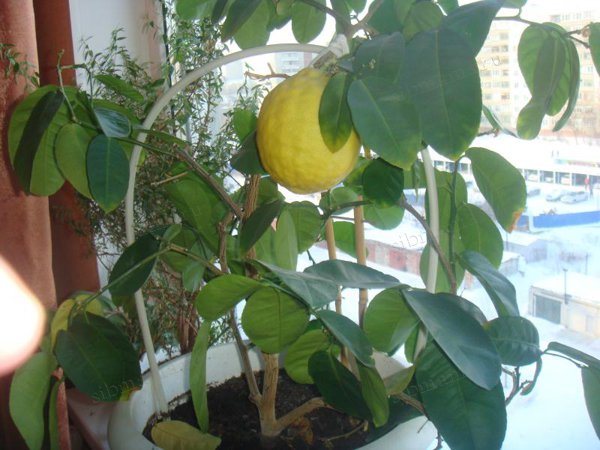
Watering
Lemon loves moderate humidity and does not tolerate both drought and strong moisture. But the soul is very fond of spraying it or bathing in the bathtub under the shower, using a spray gun: spray the leaves 3-4 times a week with water. Overabundance of moisture leads to rotting of the roots, and shortage leads to attack of ticks.
Additional fertilizing
Lemon is very picky. You need to apply fertilizer once a month, complex, better for citrus fruits. If the leaves become yellow, then you need to make fertilizer with an increased content of magnesium.

As a fertilizer, you can use slurry, sawdust and ash, as well as mineral top dressings, which contain nitrogen. You can add a couple of grams of zinc or copper.
Flowering and fruiting
Blossoms a lemon from spring to autumn. Abundant blooms in March. To accelerate the flowering you need to do a pinch of the plant. When new shoots grow, they need to be pricked or cut, so that there are 3-5 leaves on the shoot. With this method of growing, lemon will look compact, the leaves are larger. Flowers are of two kinds, vapors and lemon grass. In which the flowers have a large pistil, it means that this little flower will be tied with lemon. Experienced lemonologists believe that each fetus feeds 9-10 leaflets. Depending on the number of leaves you need to leave the crop.
I want to present you another article from the cycle "The Garden on the Windowsills." In this article we'll talk about growing lemonsat home .
Homemade lemons - universal healers, the richest suppliers of vitamins. This evergreen tree with fleshy leaves can decorate any interior and will become the pride of the owner. The very process of growing a lemon is one of the most fascinating activities in floriculture. What is useful?
- A generous, uninterrupted supplier of valuable vitamins to your table.
- A unique ionizer of air in the house. Leaves lemon in the home isolate useful volatile volatile products that refresh the microclimate, fill the air with the healing aroma of essential oils.
All the secrets of a home doctor

In fact, a lemon is a hybrid. A mixture of bitter orange and citron. Its official name sounds like Citrus Limon (Citrus Limon). This tree with competent care is able to provide your household with up to 50 fruits per year (the fruit depends on the plant variety).
We will talk at once to get a fruit-bearing lemon at home, we need not only to grow it from the bone, but also to plant it. You can use already vaccinated, young seedlings, but it's expensive and not so interesting. Therefore, we reserve ourselves with patience and nurse our fragrant pet on our own. In the house, the best way to get accustomed to, quickly begin to bear fruit such kinds of domestic lemons as:
- Meyer. Short stature. Fruits with a more acidic taste, they can be eaten not ripe.
- Pavlovsky. The height of the lemon can reach 2 m. Large fruits with thin skins, very fragrant. The most adapted to home conditions. Well reproduces cuttings.
- Novogruzinsky. Fruits have a strong, delicate flavor, almost no seeds. Fruiting can all year round. The trunk has many spines.
- Genoa. Small growth, this lemon in the home is very fruitful, brings a juicy, tasty fruit.
How to grow a lemon from a stone

Seed selection is one of the main conditions for the appearance of a strong, healthy lemon in the home. Choose from the lemon fruit the largest bones in the amount of 10-15 (to ensure a seedling is obtained). You do not need to dry them (this will slow the germination). Bones must be soaked in epine (4 drops dissolved in 100 ml of water).
- Epin. Plant immunomodulator, regulator of their growth. It can be purchased at any hardware store.
After a daily stay in the healing solution, transplant the bones into the ground. The soil can be purchased ready (for citrus fruits). Or do it yourself.
Land for young lemon grass
- leaf earth 1 part;
- turf ground 2 parts;
- humus (compost) 1 part;
- clean, washed sand 1 part.
The mixture is thoroughly sieved to remove unnecessary impurities and lumps. To bones of a lemon in house conditions have well undertaken, it is necessary to plant them in small plastic containers (it is possible to take glasses). Do not forget to make holes in their bottom for drainage.
Bones are placed in the loosened soil by 2 cm centimeter and put in a warm place. Watering is not necessary (rootlets can rot in a moist environment). It is better to make a "mini-greenhouse" for future young lemon trees (cover them with glass jars, or wrap the cups with plastic wrap).
Growing a lemon in the first stage should take place in a warm room, where the temperature should not fall below + 18 ° C. After 3 months you will be pleased with the first shoots. When the leaves appear, the baby is ready for a transplant.
Adult lemon in the home
Pot
It is best to buy a clay pot. Clay is a moisture regulator. If the soil is excessively moistened, the clay absorbs excess moisture, and if there is a lack, it will willingly give it to the plant. At the bottom of the pot, drain.
- Drainage layer. A small layer of material that can quickly remove excess water during irrigation. It fits in the bottom of the pot. As a drainage layer you can use small clay crocks or pieces of red brick, expanded clay, coarse, coarse sand, pebbles, even crumbs of styrofoam or wine cork.
To make the lemon feel more comfortable at home, cover the drainage with an additional layer of 2 cm from moss, peat or dried manure.
Land for an adult plant
- humus (compost) 1 part;
- turf ground 3 parts;
- leaf earth 1 part;
- sand one part.
Immediately after planting, the young germ of lemon is placed on the window sill of the north or west window (there is the least sun). A week later, the tree is ready to begin living on a warm window of the southern direction. Such a small preliminary hardening will help to strengthen the health of the plant, make it stronger.
How to grow a lemon at home
| Operation | Season | What a lemon loves | Advice | Notes |
| air t ° | spring Summer | common room t ° | southern window (lemon is very sensitive to climate change) | the best t ° for flowering, fruit setting from + 15 ° to + 18 ° С |
| autumn winter | from + 8 ° to + 14 ° С | transfer the lemon to a light, insulated balcony, or fence the window sill with Plexiglass | after a period of rest, gradually accustom the lemon to a rise in temperature | |
| Shine | spring Summer | bright diffused light | in the morning, evening hours - direct sunlight, in the afternoon (from 12 to 16) light penumbra | some varieties of lemon love heat (Meyer's lemon), other varieties can do with artificial lighting |
| autumn winter | high-grade lighting | at t ° from + 5 ° to + 14 ° C no backlight is needed, if t ° above + 16 ° C additional lighting is required | to lighten the lemon at home can be fluorescent lamps (white, blue spectrum) | |
| Watering | spring Summer | copious drink | the soil must be allowed to dry in the upper third of the pot to the next watering | pour lemon at home with best-kept tap water |
| autumn winter | rare, moderate watering | watering depends on t ° air in the room, make sure that the soil does not dry completely | in winter, provide breathing to the roots - often loosen the ground so that the water does not stagnate | |
| Air humidity | spring Summer | humid climate | sprinkle lemon in your home regularly in a warm period | suitable humidity 60-70% (if it is rainy), if the weather is dry, hot - humidity not less than 50% |
| autumn winter | moderate humidity | if the tree is in a residential area, spray it in the winter | in the heating season humidity will be ideal in 20-30% |
Lemon food
In the beginning of summer (its first half), feed it with fertilizers. They will increase the sugar content of future fruits and reduce their bitterness. Fertilizers for lemon at home are only applied to moist soil once a month in winter. From March to October, feed lemon in a month's time three. Fertilizers are suitable for him.
- Lemon is very afraid of chlorine! Even a small part of it can ruin a tree. Do not allow chlorine to be added to the fertilizer.
Lemon transplantation
Homemade lemons must be transplanted once a year. But the transplant can not be done if the earth's clod is not braided by the rhizome of the plant. In this case, simply replace the drainage and topsoil from the tree.
Fruit-bearing trees need to change their place of residence every 3 years. Usually this procedure is done in February-March. When you replant lemon at home, carefully handle the earthy lump - do not damage it. The plant may not suffer the trauma of its root system.
To the new soil, you can add coals of birch or alder (a glass on a bucket of land), it will also be useful to add pine bark (put 1 cm of bark on the bottom and pour a liter of water) and vermiculite in the same proportion.
- Vermiculite. Layered, environmentally friendly mineral, protects the roots of plants from fungal diseases. Before use, vermiculite should be slightly moistened.
If a lemon has been living in a pot for a long time, you need to mulch it (top up fresh earth or compost). Provided, of course, that the soil has fallen down, caked. The top soil layer must be changed and when a whitish salt coating appears.
Looking forward to the long-awaited fruit
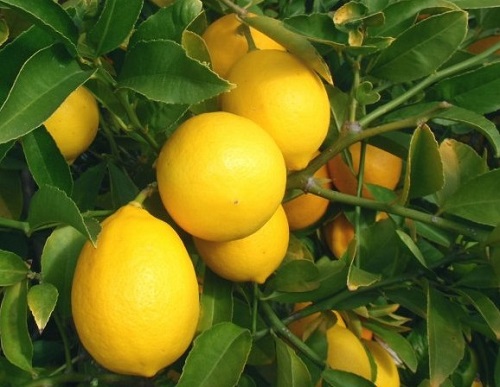
Lemon in the home (grown from the stone) usually begins to bear fruit in 5-8 years after planting. Do you want to rejoice in his first juicy fruit after a year? For this we need to plant it. The most convenient ways of grafting two. Prepare in advance:
- garden knife (you can take a razor);
- elastic tape (tape, tape);
- garden var (you can use oil paint, which is covered with fresh cuts of plants).
Method of budding (budding)

You can do leukemia at home at any time. On the bark of the tree with a knife we make a neat T-cut (length 3, width 1 cm). Ideally, if you get an eyepiece knife for this purpose. With its help, you can carefully bend the bark in the place where we will put the kidney.
We cut the kidney from the cut first. Carefully take it by the petiole of the leaf and place it in the incision. Bend the bent bark back to its previous state. Fix the graft area with an elastic band. But leave the kidney visible. And cover this place with water (not to get water). After three weeks, the result will appear - the petiole will fall off. Remove the dressing, remove the var. Your lemon is fertilized for the second year.
Method of cleavage (cuttings)
Cuttings can be grafted at home in cuttings only in April and May. The tree should not be older than 3 years and have a barrel diameter of about 2 cm. We need a shoot of 10 cm of an annual healthy plant taken from its upper portion. Remove all leaves from the cuttings and wrap them in a damp cloth, wrap them with plastic wrap. Keep it that way for 3 days. You can put the shank in the fridge, then it will remain for a longer time.
The lemon tree itself for 3 days before inoculation pour abundantly. At home it is better to plant a tree in a cleft in the center. Cut the lemon crown at a distance of 10 cm from the ground and split the trunk to a depth of 3 cm. At the base of the cut, make two oblique cuts and insert it into the cleavage. Wrap this place with a tape, fix it with a fog. The grafted lemon should be in a high humidity environment, protect it from the action of direct sunlight.
A roomy lemon, grown with its own hands, will give the owner a lot of pleasant moments, from the appearance of the first young sprouts and ending with the first fruits. With his appearance in the house, you will forget what colds, beriberi and stress are.

Good luck to you and your lemon tree!
See you soon, dear readers!
Features of indoor lemons
Lemon - the plant is subtropical. It grows where there is a lot of heat and moisture that must accompany it all year round. Lemon trees die with a drop in ambient temperature to minus 4 degrees. Still lemons light-loving. It should be remembered that direct sunlight when growing indoor conditions depress the plant, sometimes causing the fall of the foliage.
In nature, lemon leaves do not fall off at the same time. This is not only the organs of photosynthesis, but also a peculiar pantry of useful substances.
How to grow a lemon at home
When growing there is a direct relationship between their number, intensity of development and yield.
Lemons in the home grow with a certain periodicity. A new growth starts when the young foliage finally ripens. The first wave of growth lasts from late March to June. The second begins after a brief period of rest from mid-June to early August, and the third - from about the second decade of September to the last days of October. From November to early March, lemons are at rest. For a year the trees grow 15-20 cm.
Often the apical bud dies and falls off during the dormancy period, while the young leaves develop rather quickly. Every time the growth stops, young shoots ripen. The next increase begins after they have got stronger. The upper buds germinate first and develop better than the lower ones, that is, vertical shoots are more active in growth, in contrast to horizontal ones. On the vertical - very rarely the fruit is tied, so the crown must be formed. How well it is formed, the timing of the beginning of fruiting depends.
It all starts with a seedling
You can not buy lemons seedlings brought from the south. They are mostly grafted on trifoliat, which fall asleep during the winter. Such seedlings in the room conditions drop the leaves and die.
Even if the vaccine is carried out on lemons at home, the southern seedlings in the north feel bad. Leaves of such grafts are formed from the calculation of excessive southern illumination. With a sharp change in these conditions, plants simply can not function normally.
It is best to buy them from a local lover who has experience in growing lemon at home and can consult if necessary. The seedling should grow in a commensurate pot and have three-four-year-old leaves.
You can not buy seedlings for cultivation with a bare root system. The fact is that it does not have thin villi for suction nutrients and moisture from the soil. Mycorrhiza fungi live on the smooth tips of comparatively thick roots. If the root system remains naked for at least a short time, mycorrhiza dries quickly, and the seedling dies shortly after disembarkation.
Crown formation and cultivation
When young shoots grow out from under the adult leaves, begin to form the crown. Each branch is shortened to five or six leaves, and then, when it becomes large, the leaves - a wide, dark green, solid, scissors or pruner cut a twig with two leaves. Subsequently, on the left side, two new shoots will grow, which again will have to be shortened. A beautiful tree can be formed within two years.
Allow to bloom and fruit the plant should be at three to four years of age. Do not leave too much ovary. Fruits will form and mature, but will their young plant stand? It can be ill or die for a long time.
Ten mature leaves are able to ensure the full development of one fetus under room conditions. Guided by this rule, excess flowers are removed. This is best done when they are still in buds.
Tree care and further cultivation
Determine the place where the lemon will always stay at home. The sapling must be acclimatized to the living conditions for one to two months. After this, it should be transplanted into a roomy pot with an opening in the bottom.
The root system of the plant is superficial, so the soil in the tank must be drained. To do this, put a piece of broken ceramics over the hole, and then pour the charcoal with a layer of 4-5 cm (it also reduces the acidity of the soil). If there is no coal, claydite can be used. Drainage is sprinkled with a nutrient earthen mixture consisting of soil from under deciduous trees (except oak) and sand (3: 1). To the mixture, you can add three spoons of ash and a glass of free flowing humus.
The best land for growing indoor plants is from croton. The soil that moles dig, building a home, very nutritious, fluffy, thoroughly cleaned of insects. If a tree is transplanted into such a land, then it is possible to do without feeding. Note that for lemons, the acidity of the soil is very important. Best of all, they develop at pH 5.5-7.5. Increased or decreased acidity causes micronutrient deficiencies even with regular fertilization, because most substances are transformed into a form inaccessible to plants.
When a pot of soil is prepared, the plant is removed from the old flowerpot. Any citrus transplant with a clod of earth, so as not to disturb sensitive roots. Such a transplant is called a full transshipment. It is important not to sprinkle the root neck (the junction of the root with the trunk) with a layer of soil thicker than 1 cm, otherwise it will start to rot.
After the transplant, the lemon is watered at home with water at room temperature, in which crystals of sodium permanganate are dissolved. In the future, it is transplanted only if the roots are completely weaved by an earthen lump in the pot. You can see this by the spines that exit through the drainage hole.
Transplanted also when the tree stops growing, underdeveloped branches appear, the leaves turn yellow. It is best to transplant in February. Here the question arises: why can not a seedling be planted immediately in a pot of impressive size, so as not to do this every year? Yes, because the root system of a small tree covers, respectively, a small amount of earthy coma, and the rest - the "idle" earth - is sour.
A pot of seedlings is wrapped with a layer of cotton wool, batting or foam rubber and aluminum foil. This way of growing the root system is like in a thermos: in the winter it will not be cold, but in the summer it will be hot.
For better illumination of plants in the winter from the side opposite from the window it is desirable to install a screen of aluminum foil. If there is heating under the window, it is better to cover it, so that warm air does not get on the leaves.
Lemon at home can not be moved from place to place and turn in different directions. This can lead to the loss of leaves and the death of the seedling.
Watering and sprinkling of lemons at home
It is better to water a tree with rain or melt water. However, often it is necessary to take it from the tap, which contains disinfectants. In order not to cause damage to the plant, it is necessary to defend the water for irrigation.
Water from a well often contains mineral salts, most often lime. With constant watering, the soil is saturated with "ill-wishers" enough that it acquires an alkaline reaction, and the plant loses its ability to absorb iron, manganese, zinc and further cultivation becomes difficult. The leaves of the lemon become pale, covered with spots. If the tree is not transplanted, then it will disappear altogether. Soft water hardens simple boiling or lemon (0.5 g per 1 liter), nitric acid, acetic acid (4 drops per 1 liter).
At any time of the year, it is important to sprinkle lemon daily at home. Especially it should be done in winter, when the air is too dry. This activity helps to reduce the evaporation of moisture by the leaves and thereby facilitates the vital activity of the roots and the growing takes place more intensively.
How and what to feed in growing
First time a lemon at home is fed 30 days after the transplant. In winter - once a month, and in the spring-summer period - once a week. It is advisable to regularly change the set of nutrients. Dry chemical fertilizers are not recommended, because they contain chlorine compounds, sulfurous and fluoric substances, which adversely affect mycorrhiza.
An available fertilizer is used tea tea, coffee grounds (they are scattered on the surface and mixed with the soil), water in which the meat and fish were washed. Once a month, watered with a solution of ash (1 tablespoon per liter of water).
It is good to feed the plant with a decoction of unsalted fish. To do this, take 200 g of waste after cleaning, cook in 2 liters of water for 30-40 minutes, cool, filter and dilute (1: 1) with boiled water.
The main and effective fertilizer is manure. But how to use it in a city apartment? Firstly, we need not so much, and secondly, the dried manure has practically no smell. You can use chicken manure, cow and horse manure.
Cultivation using a life-giving solution: liter jar filled with manure (1: 1), tightly closed and put to wander for 3-4 weeks. This "infusion" citrus treats twice a month. The ratio for horse manure is 1: 8, Mullein - 1:10, chicken manure -1: 25. It will be useful to recall that it is important to adhere to this dosage, since smaller concentrations are ineffective, and large ones are harmful, can burn the plant.
To avoid pests
Finally, about the sorrows that can befall the owners when growing indoor lemons. They arise with the appearance of pests, and most often they are brought together with a new indoor plant or flower bouquet. In summer, pests enter the room through an open window, so it must be tightened with a dense mesh.
Prevent the emergence of unwanted guests can be, if organic fertilizer before use pour boiling water, and the ground during transplantation warm up well or steamed.
Pests settle and feel good on plants that stand in a room where the air is too dry, or on the windowsill, where the year-round positive temperature. Do not allow thickening of plants, dust on leaves and branches. Preventing the appearance of pests will be a strong shower, which will wash the crown and leaves from all sides.
How to grow a lemon at home - video
Among the florists has become very popular growing citrus plants in the home. Especially for these purposes, breeders were brought out mini-varieties of orange, mandarin, grapefruit and lemon, as well as other species. In this article we will talk about the last of the listed
Lemon at home. Growing it can create a number of difficulties, since this small tree is very fanciful. In order that tsitrus pleased you not only with its evergreen, bright leaves, but also with time began to bear fruit, it is necessary to adhere to some rules for caring for it.
Lighting
The largest number are light-loving, except for some of them (Pavlovsky, Jubilee). For them, the northern and north-western windows of the apartment are good. The remaining plant varieties can be located near the solar southern and south-eastern windows. However, in this case, too, pritenyat lemon: growing it can be complicated by direct sunlight, as the leaves can get sunburn. At the onset of winter, citrus should be placed in the brightest place in the apartment, but it must be remembered that this tree is wintering in the cool.
Pots. Substrate
It will be quite comfortable to grow the cultivation which is best managed in the spacious it improves the access of air to the root system. Soil for plants can be purchased in a store, it must be loose, but very nutritious. In order to make the soil at home, you will need to mix humus, turf and sand in the proportions of 1: 3: 1.
Watering and humidity
Citrus fruits do not tolerate dry air, so do not put them near batteries. If there is no other suitable place for plants, then the battery should be covered with a wet rag. Like all citrus trees, in summer it is necessary not only to water abundantly, but also spray your water with a spray of your lemon. Growing in the home of such capricious plants always requires soft water: it should be boiled or defended within a day, even better - 2-3 days. Sometimes it is necessary to rinse the trees under a warm shower (small specimens) or to wash the leaves with water and cloth (adults and large plants). In the winter season, watering is reduced, as this can lead to stagnation of water and decay of the root system (an exception can be made if your trees have fruits at this time of year).

Additional fertilizing
It will not be bad to produce fertilizing with mineral fertilizers. This should be done during the period of active growth of the tree, that is, from spring to late autumn. Addition of citrus is necessary not only for its healthy growth, but also for the beginning of fruiting.
Ovary and fruiting
If during the flowering there is no way to put the plant outside, then pollination can be done by itself with the help of an ordinary one. To do this, gently take the pollen on the brush from one flower and transfer it to the other. So you need to do with all the colors. How soon will the lemon be produced at home? Cultivation took place according to all the rules - hence, you can wait for the harvest for the third - the fourth year.
It is worth remembering that fruit only in rare cases happens that plants grown from a bone, form ovaries. And then, most likely, it will be vapors.
Temperature conditions
Optimal for this plant in winter is the temperature of 12-15 gadusov. High it is considered already at 23 degrees, if the air is dry and hot - the leaves begin to curl up and dry up.
Transfer. Trimming
A young citrus tree is transplanted two or three times a year, given the growth rate, and older plants are transplanted every few years (usually 2-3). It should be done in the very beginning of spring, while watching that new shoots and especially the ovaries of flowers do not yet form on the tree. When transplanting, you need to consider the location of the root system of the plant. The root cervix should be placed slightly below the level of the pot.
Like many other plants, good drainage requires a lemon at home. Cultivation of it is made, as already mentioned, in a spacious container, on the bottom of which it is possible to pour coarse-grained sand, small river or sea pebbles also fit.

With the right and caring care, this citrus will please you with its fruits annually, and its bright green foliage - throughout the time of being in your apartment.
Everyone knows a lemon - this evergreen perennial - a guest from the subtropics, which is quite comfortable settled in our houses, apartments. The homeland of lemon - Southeast Asia, more than a thousand years ago, these fruits were imported from India, and eventually found popularity in Africa, America. This deservedly popular citrus can live in your home. How to grow a lemon from the bones at home, you learn from this article.
This citrus tree gives color several times a year. Home-grown lemon fruit is characterized by a finer crust, a more intense flavor than those grown on open ground. To grow a lemon from a bone, you need to create for him comfortable conditions: high-quality ventilation, lighting, periodic fertilizing with fertilizers, an individual approach according to the time of year.
One of the main stages is the selection of quality seeds - this is the guarantee of the future harvest. For the planting material, the bones from the purchased ripe lemons are quite suitable. Sow at once a lot of bones, so that you can then choose the strongest sprouts. 
How to plant a lemon from a stone?
Step by step process:

Here, a young seedling from the bone should grow to about 17-20 cm, after which it is transplanted. The volume of the new pot should be larger than the previous one.
Lemon room - home care
This tree loves bright, but diffuse light, so that in summer the scorching sun rays do not harm the leaves, it needs to be shaded. Here, as with watering, you need to adhere to the golden mean, since with a lack of light, the fruits will be acidic, and the leaves are flaccid and sparse.
Optimum temperature regime for flowering, fruit formation (tie) - approximately + 17..20 ° C.
Lemon room does not like when it is moved from place to place, but staying in the open air (for example, on the balcony), it still does not hurt. Keep an eye out for the weather forecast, as a sharp temperature drop can harm the plant (it will throw off the foliage). Wintering should take place in cool home conditions, a temperature of + 15..18 ° C will be enough.
How to care for a lemon in terms of watering? Like all citrus cultures, he loves moisture. In summer, it is necessary to provide copious watering to the perennial, twice a week is enough. In winter, one watering is enough for a week. Overflow should be avoided. At the same time, water should be boiled, have room temperature or be well-kept. This plant does not tolerate chlorine, which is rich in tap water - consider this factor.
Photo of a lemon room at home: 
Citrus fruits require frequent irrigation of the crown with moisture. This is especially true in the summer, and in the winter (with constantly working batteries or heaters) spraying becomes simply necessary. Sometimes you can arrange a warm shower plant - this is a good prevention against the appearance of mites, scutes. To further increase the humidity, a pot of lemon can be installed on a tray with wet claydite (or charcoal, gravel).
Fertilizer for indoor lemon is an indispensable condition for harmonious development, fruiting. In comparison with other domestic perennials, this citrus needs to be fed more often than its green counterparts. In summer, fertilizers are introduced weekly (with water for irrigation), in winter - once a month will be enough.
Mineral top dressings are more effective, but organic contain all the important trace elements, have a beneficial effect on the soil structure, activate vital activity of all important microorganisms. If you combine minerals with organic, then such an alliance will provide the best nutrition for this citrus at home.
During the activation of shoot growth (in the spring) it is appropriate to introduce potassium, nitrogen fertilizing, and when the flowers appear phosphoric. Carefully study the information on the package with fertilizers - compliance with the dosage is very important, as you will subsequently use these lemons. With the onset of the so-called "rest period" (autumn-winter time), the dose and frequency of fertilizing decreases to one time per month.
Lemon transplantation into a new pot, pruning, shaping the crown
Every year, preferably in spring (the beginning of vegetation), lemon is transplanted. Transplantation should be carried out carefully, so that the perennial root system is not disturbed. The method of overtaking is most preferable for this case. Every year only young specimens are transplanted when they reach the age of 3 years (some varieties are 5 years old), the transplant is performed every 2 or 3 years. It is highly discouraged to carry out this process during flowering or fruiting - the plant can discard inflorescences with fruits.
Do not forget that quality drainage at the bottom of the tank is a prerequisite for citrus cultures. The size of the pot is also important, since if the capacity is too low, then the plant will not have enough land or nutrient components. Too large pot, too, will not work - the soil will be sour, and the root system will rot.
Pot for lemon - size (diameter):
- small shrubs up to 2 years old - about 20 cm;
- plants 3-4 years - 30 cm;
- young trees 5-6 years - 35 cm;
- citrus older than 7 years - 45 cm.
It is desirable that the pot was made of clay, but wood, glass, plastic are also acceptable, the main thing is that the tank has drainage holes.
To give the crown shape, remove excess branches is also better in the spring (April), until the active growth of shoots began. At the first formation of the crown, the trunk of the bush is cut at a length of 25-30 cm.  On the sides there are the strongest buds (these are shoots of the first order), from which after grow skeletal branches. Usually there are three or four of them, make sure that they are located evenly, because the beauty of the future crown depends on this. Each successive order of shoots need to pinch 5 cm shorter than the previous one.
On the sides there are the strongest buds (these are shoots of the first order), from which after grow skeletal branches. Usually there are three or four of them, make sure that they are located evenly, because the beauty of the future crown depends on this. Each successive order of shoots need to pinch 5 cm shorter than the previous one.
Most citrus fruits are observed on the branches of the 4th and 5th order, these branches grow in the second or third year of life.  On branches of the first order, fruits are not tied at all, and on branches of the 2nd and 3rd order - only in certain varieties (for example, Meyer).
On branches of the first order, fruits are not tied at all, and on branches of the 2nd and 3rd order - only in certain varieties (for example, Meyer).
 Lemon Meyer
Lemon Meyer
The number of flowers should also be controlled so that the vital forces of the plant are not exhausted. In order for the tree to develop harmoniously, at about 3 years of age it is necessary to start removing half of the inflorescences (the harvest will be smaller, but the fruits will be larger), and leave 3 or 4 pieces out of the ovaries. For the same purposes, in a year, you can leave 5 or 6 citrus, and for the future not leave more than 7 or 9.
Branching branches can be gently, without excessive enthusiasm, cut to the eye, so that the crown visually had an attractive shape. It should be borne in mind that short circumcision provokes the growth of new powerful shoots, and the long one promotes the birth of fruit buds.
The skeleton of a tree is considered formed after the young growth of branches grows, will grow lignified. Correctly formed crown gives all the leaves the required amount of light and air.
How to pinch a lemon? If it actively branches, it forms shoots, then unnecessary fragments should be deleted as soon as they appear. In those shoots that are left for development, the tops are plucked after the appearance of the 6th leaf. 
Diseases of indoor lemon
 Often, the disease appears due to non-compliance with the rules of care: nedoliv leads to the drying of the tree, with a glut of moisture, the root system rot and the leaves turn yellow.
Often, the disease appears due to non-compliance with the rules of care: nedoliv leads to the drying of the tree, with a glut of moisture, the root system rot and the leaves turn yellow.
If the foliage becomes covered with yellow specks, and after it turns pale and dries, then the lemon, most likely, lacks iron. 
If the leaves dry the tips, and they themselves seem to rust, then this indicates a lack of phosphorus.
The lack of potassium leads to the wrinkling of the leaves, and with the deficiency of manganese, the ovaries are completely discarded.
A competent, timely fertilizer of the plant is an ideal prevention of the above-described negative manifestations.
Little to know how to grow a lemon, you need to know how to protect it in a timely manner. Weakened plants are the first to enter the risk zone, they are the ones that are most often affected by diseases. Proper care is the basis of lemon content at home. If the tree is sick, then the affected leaves, flowers, fruits, branches should be removed immediately. If a pest is detected, it is necessary to immediately carry out a protective "attack", but after certain types of processing, the lemon can no longer be eaten.
Good results show the drug "Fitosporin". It suppresses an extensive spectrum of causative agents of citrus diseases. It is also good in that it has no odor, does not contain toxic compounds. It is diluted with water during irrigation, irrigates the plants. This drug is very good for disease prevention.
Communicating with friends of interest, you can often hear complaints: "room lemon dropped leaves, what to do?" The main reasons for this reaction are insufficient lighting, overflow or underflow, depleted soil, excessive dryness of the air, heat or cold. For reference, we list the most common diseases of domestic citrus, we give a brief recommendation for eliminating the cause:
- Scab or warty - has a fungal origin, manifests itself on young shoots and leaves: first appear pale yellow spots, which later become warts grayish color. The growths grow, cover shoots, which subsequently perish. The scab also affects the fruits: bright yellow spots appear on them, which then turn red and darken. All affected parts of the plant must be cut and destroyed, and the trunk with the crown should be richly treated with 1% Bordeaux liquid (mixture of copper sulfate solution and lime milk).
- Anthracnose is the most common fungal cause of why the leaves of a room lemon turn yellow at home. With this disease the tree loses buds, the fruits appear brown spots, the branches die. All affected shoots, fruits must be removed, and the plant itself should be treated with the above-described preparation "Phytosporin" or Bordeaux liquid.
- A black fungus is a consequence of defeat by pests - a mealybug or a scab. Active preventive measures are a sure way to protect the tree from such consequences.
- Gummosis - manifested by the appearance of dark red spots on the trunk and branches, on the places of damage the cortex cracked, a sticky liquid (gum) emerges from the crack, which subsequently solidifies. The causes of this disease are many: improper penetration of seedlings, "dirty" soil, mechanical "trauma" of the plant, improper care for a room lemon. Treatment - finding out the root cause of the disease, as well as radical cutting of the affected areas with an acute knife. Damage should be treated with a 3% solution of copper sulfate, and then covered with garden varnish.
This citrus perennial must be regularly inspected to notice the disease at the very beginning. As you know, any disease is easier to cure at the initial stage. You need to inspect not only the trunk or foliage, but also the root system of the tree, the soil.
Lemon in the apartment - good or bad
Of course, the benefits from it are much greater than the possible harm. Everyone knows the medicinal, protective properties of this citrus for the human body. Vitamins, flavonoids, biologically active substances successfully suppress viruses, create a powerful shield against pathogenic bacteria.
The use of this yellow citrus strengthens the immune system, normalizes the hormonal background, improves eyesight, stimulates the digestive tract. Lemon mobilizes the body's internal resources, helps with sore throats, colds. Widely its application in cosmetology: face masks (whitening, healing, cleansing) and hair (growth stimulant). Even just a green tree (room lemon from a stone, at home grown) saturates the air with phytoncides, raises the mood, facilitates breathing.
Contraindication to use may be individual intolerance, peptic ulcer of stomach, duodenal ulcer, chronic gastritis, pancreatitis. In everything you need to know the measure, since eating a lemon in large quantities will not lead to anything good.
Given all of the above, now you know how to grow a lemon from a stone at home. Despite the abundance of information, this process does not require special knowledge or skills. It is necessary to understand and take into account the main criteria - the rules of maintenance and care, competent pruning, timely prevention of diseases.


